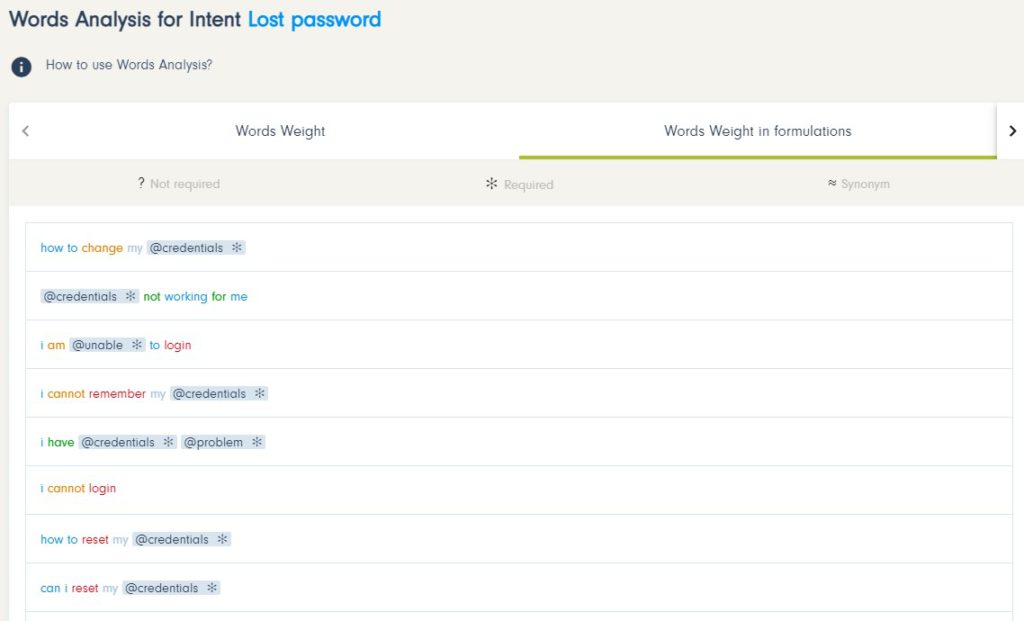- What does it stand for?
“Words Analysis” is a precious help for you to understand how does matching work for each of your intents, putting forwards words that have the strongest weight, and on the opposite those who have a weak weight and who will consequently be very lightly taken into account by our NLP (= Natural Language Processing) engine.
This functionality comes with all the necessary tools to change these weights and consequently ensure that the discriminatory words of your intent have a strong weight, whereas those who are not (for example “want”, “why”, …) have a weaker weight.
2. How does that work?
A) “Words Analysis” for an intent
“Words Analysis” page is available from the “Analyze” tab of the platform.
⚠️ You must train your bot to see data ⚠️
The left part of this page contains a list of all your chatbot’s intents. You can select one item at a time, to see its “Words Analysis” page.
⚠️ Only the intents that trigger a story and / or a quick answer intent have a “Words analysis” page. If not, a small icon is there to indicate it to you. ⚠️

Select the intent you’re willing to analyze.
Two tabs are displayed:
- “Words weight”: overview table displaying all the intent words with their weights, allowing you to see at a glance if there is any anomaly. Each word is clickable, except pronouns and determinants, for which the weight is automatically fixed at its weakest level.

- “Words weight in formulations”: all your intent’s formulations are displayed there, and each word of each formulation takes the colour that corresponds to its weight. They’re all clickable. As for entities, they’re displayed with small icons that represent their type (“User-defined” or “Built-in”) and their behaviour (“Synonym”, “Required” or “Non-required”).
Indeed, their behaviour will have an impact on the matching. Unlike “Built-in” entities, “User-defined” entities are clickable. On click, you reach the “Words weight” table for this entity values.
Moreover, on click on “Random Formulation Examples” on the right of a formulation, you can generate random formulation examples, with random values for entities.

Information for an entity is detailed on hover if needed.

⚠️
- Pronouns and determinants are not taken into account in the table. Indeed, their weight is automatically fixed at the weakest value. That is why they’re displayed in a light grey color.
- If you just did an edit on your intent, you must train your bot for this edit to be taken into account.
The following statements are related to the way that our NLP engine interprets the formulations it receives:
- If one of your formulations contains a contraction (of example “I’d” instead of “I would”), then the words will be fully displayed in “Words weight in formulations” part. In fact, the weight of each of these words has an impact on the matching.
- In “Words weight in formulations”, all the words are displayed in lowercase letters.
⚠️
B) “Usage” for a word
On click on a word, from either the table “Words weight” or “Words weight in formulations”, you land on its “Usage” page. This page aims at listing all the places where its stem is used.
As a consequence, you directly understand its weight and you can change it by deleting or adding it in the intents and / or entities for which you judge it relevant. Indeed, if a word has a weak weight, that means it is used in an important number of intents and / or entities.
On the contrary, a word that is used is only one intent will be discriminatory and have a very strong weight.
For each intent of the list, you have 2 possibilities:
- click the intent: a section displays at the bottom. It contains an overview of all the word’s stem occurrences in this particular intent.

– 2 times as a word in intent formulations, 1 time as “work” and 1 time as “works”
– never as an entity value
- click the “eye” icon: to open “formulations” tab of your intent, filtered on formulations containing the stem of the word that is being analyzed. This way, if your aim is to increase the weight of this word, you can very easily delete the non-necessary occurrences.

In the same way, you can, from each entity, open a section detailing all the word stem occurrences, or open the entity panel in order to add or delete word’s occurrences, depending if you’re willing to increase or decrease its weight.
You now hold the key to build very powerful intents and increase your users’ satisfaction! 😎